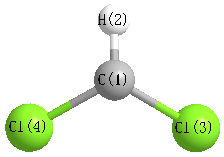Jump to
S1C2
Energy calculated at B2PLYP=FULLultrafine/6-31G**
| | hartrees |
|---|
| Energy at 0K | -958.672194 |
| Energy at 298.15K | |
| HF Energy | -958.540182 |
| Nuclear repulsion energy | 125.434292 |
The energy at 298.15K was derived from the energy at 0K
and an integrated heat capacity that used the calculated vibrational frequencies.
Vibrational Frequencies calculated at B2PLYP=FULLultrafine/6-31G**
| Mode Number |
Symmetry |
Frequency
(cm-1) |
Scaled Frequency
(cm-1) |
IR Intensities
(km mol-1) |
Raman Act
(Å4/u) |
Dep P |
Dep U |
|---|
| 1 |
A1 |
3325 |
3325 |
0.06 |
|
|
|
| 2 |
A1 |
766 |
766 |
10.40 |
|
|
|
| 3 |
A1 |
318 |
318 |
0.46 |
|
|
|
| 4 |
B1 |
387i |
387i |
55.47 |
|
|
|
| 5 |
B2 |
1282 |
1282 |
58.60 |
|
|
|
| 6 |
B2 |
940 |
940 |
154.38 |
|
|
|
Unscaled Zero Point Vibrational Energy (zpe) 3121.8 cm
-1
Scaled (by 1) Zero Point Vibrational Energy (zpe) 3121.8 cm
-1
See section
III.C.1 List or set vibrational scaling factors
to change the scale factors used here.
See section
III.C.2
Calculate a vibrational scaling factor for a given set of molecules
to determine the least squares best scaling factor.
Geometric Data calculated at B2PLYP=FULLultrafine/6-31G**
Point Group is C2v
Cartesians (Å)
| Atom |
x (Å) |
y (Å) |
z (Å) |
|---|
| C1 |
0.000 |
0.000 |
0.671 |
| H2 |
0.000 |
0.000 |
1.746 |
| Cl3 |
0.000 |
1.481 |
-0.170 |
| Cl4 |
0.000 |
-1.481 |
-0.170 |
Atom - Atom Distances (Å)
| |
C1 |
H2 |
Cl3 |
Cl4 |
| C1 | | 1.0755 | 1.7025 | 1.7025 |
H2 | 1.0755 | | 2.4213 | 2.4213 | Cl3 | 1.7025 | 2.4213 | | 2.9613 | Cl4 | 1.7025 | 2.4213 | 2.9613 | |
 More geometry information
More geometry information
Calculated Bond Angles
| atom1 |
atom2 |
atom3 |
angle |
|
atom1 |
atom2 |
atom3 |
angle |
| Cl3 |
C1 |
H2 |
119.579 |
|
Cl3 |
C1 |
Cl4 |
120.842 |
| Cl4 |
C1 |
H2 |
119.579 |
|
Electronic energy levels
Charges, Dipole, Quadrupole and Polarizability
Jump to
S1C1
Energy calculated at B2PLYP=FULLultrafine/6-31G**
| | hartrees |
|---|
| Energy at 0K | -958.673072 |
| Energy at 298.15K | |
| HF Energy | -958.541065 |
| Nuclear repulsion energy | 125.248575 |
The energy at 298.15K was derived from the energy at 0K
and an integrated heat capacity that used the calculated vibrational frequencies.
Vibrational Frequencies calculated at B2PLYP=FULLultrafine/6-31G**
| Mode Number |
Symmetry |
Frequency
(cm-1) |
Scaled Frequency
(cm-1) |
IR Intensities
(km mol-1) |
Raman Act
(Å4/u) |
Dep P |
Dep U |
|---|
| 1 |
A' |
3282 |
3282 |
2.01 |
|
|
|
| 2 |
A' |
773 |
773 |
16.59 |
|
|
|
| 3 |
A' |
505 |
505 |
26.50 |
|
|
|
| 4 |
A' |
312 |
312 |
0.60 |
|
|
|
| 5 |
A" |
1286 |
1286 |
49.17 |
|
|
|
| 6 |
A" |
908 |
908 |
180.29 |
|
|
|
Unscaled Zero Point Vibrational Energy (zpe) 3532.7 cm
-1
Scaled (by 1) Zero Point Vibrational Energy (zpe) 3532.7 cm
-1
See section
III.C.1 List or set vibrational scaling factors
to change the scale factors used here.
See section
III.C.2
Calculate a vibrational scaling factor for a given set of molecules
to determine the least squares best scaling factor.
Geometric Data calculated at B2PLYP=FULLultrafine/6-31G**
Point Group is Cs
Cartesians (Å)
| Atom |
x (Å) |
y (Å) |
z (Å) |
|---|
| C1 |
0.012 |
0.695 |
0.000 |
| H2 |
-0.483 |
1.654 |
0.000 |
| Cl3 |
0.012 |
-0.171 |
1.477 |
| Cl4 |
0.012 |
-0.171 |
-1.477 |
Atom - Atom Distances (Å)
| |
C1 |
H2 |
Cl3 |
Cl4 |
| C1 | | 1.0790 | 1.7123 | 1.7123 |
H2 | 1.0790 | | 2.3994 | 2.3994 | Cl3 | 1.7123 | 2.3994 | | 2.9544 | Cl4 | 1.7123 | 2.3994 | 2.9544 | |
 More geometry information
More geometry information
Calculated Bond Angles
| atom1 |
atom2 |
atom3 |
angle |
|
atom1 |
atom2 |
atom3 |
angle |
| Cl3 |
C1 |
H2 |
116.711 |
|
Cl3 |
C1 |
Cl4 |
119.238 |
| Cl4 |
C1 |
H2 |
116.711 |
|
Electronic energy levels
Charges, Dipole, Quadrupole and Polarizability
